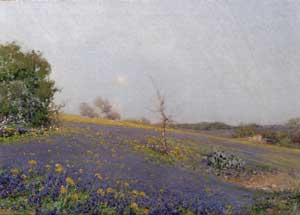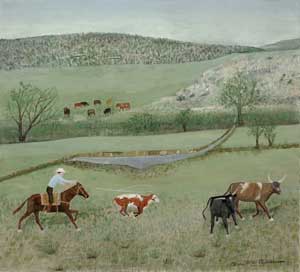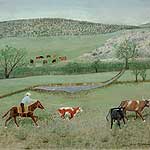The vast holdings of Texas art, both historic and contemporary, that
Dallas collectors Nona and Richard Barrett have put together over the
last 20 years are legendary among Texas art audiences for their breadth
and depth.

José Arpa y Perea...Sloping Hills...1926...Oil on canvas...30 1/2 x 39 1/2 inches...DMA, The Barrett Collection
Not merely shrewd collectors, the Barretts are also generous patrons committed to sharing their collection with Texas audiences through exhibition loans and gifts to area museums. In the late 1990s, the Barretts gave close to 250 contemporary paintings and works on paper to the Museum of Fine Arts, Houston, and in 2004 the remainder of their Texas collection — along with the fruits of their recent interest in Swiss modernism — was exhibited at SMU’s Meadows Museum in Texas Vision: The Barrett Collection. I was co-curator of the Meadows exhibition, and the experience not only brought me closer to the artists, their work, and the Barretts’ personal and professional involvement with them, but also opened my eyes to the thorny issue of the public presentation and collection of art from a regional movement.
Currently on view at the Dallas Museum of Art is Lone Star Legacy: The Barrett Collection of Early Texas Art, an installation of nearly 60 paintings and works on paper of early Texas art that the Barretts have given to the museum. The title, Lone Star Legacy, pays homage to the DMA’s seminal Lone Star Regionalism exhibition of 1986 and thus positions the Barrett’s gift in the history of the museum as much as in the history of Texas art. The subtitle lends autonomy to this selection from the greater Barrett enterprise and, by focusing on the elusive time frame of “early,” frees the installation from a chronological investigation. With the exception of the ubiquitous “Regionalist” section, Lone Star Legacy replaces the tired headings of “Impressionism” and “Abstraction” with sections that address questions of subject matter, medium and, refreshingly in the world of Texas art, gender.
The exhibition is in one of the DMA’s quadrant galleries, and upon entry the viewer is confronted with two paintings in a strong pairing that sets the tone for the rest of the installation. In lieu of a singular, dramatic entrance piece, Lone Star Legacy offers a striking contrast with two landscapes: José Arpa y Perera’s Sloping Hills of 1926 and Otis Dozier’s Texas Landscape of 1979. The similarities of the two paintings in scale and composition seem to raise the stakes in the matchup as Arpa’s bright naturalism takes on Dozier’s more subdued architectural interpretation. This playful tension, often accompanied by a chronological shift, is one of the greatest strengths of the exhibition, pointing to curator William Rudolph’s interest in a critical assessment of the works beyond the desire to pigeonhole them into easy categories.

Clara McDonald Williamson...Ropin' the Range...1957...Oil on panel...25 1/2 x 27 1/2 inches...DMA, The Barrett Collection
Another strength of the exhibition is the number of high quality works here, their potential fully realized by the installation strategy. Everett Spruce’s Low Tide in the Gulf of 1958, a splendid example of his regionalist painting, shows the artist’s distinctive blend of confident brush strokes and bold color juxtapositions, characteristics heightened to frenzied effect in his later Beekeeper of 1988. The subject of Beekeeper, that of a figure at work in a landscape, makes for a rich comparison with the adjacent Window Cleaner of 1949 by William Lester, an artist whose investigations of form and color at their best produced sculptural qualities reflective of both the power his subjects held for him and his reverence toward them.
The exhibition is particularly strong in regionalist works, and several major figures, including Jerry Bywaters, Olin Travis and Otis Dozier, are represented in depth. Three pastels by Bywaters, true gems in the exhibition, elegantly imbue the West Texas landscape with the softness of the medium. And the powerful associations of Travis’s multi-layered symbolism are heightened through an overt comparison of his iconic Mayor of Hoover City (Texas) with his Phony Cripple Beggar, a portrait of the same man removed from his former complex setting. Alexandre Hogue is another artist represented in depth who benefits from the inclusion of works from different periods in his long career. The 1924 pastel Harvest Time reveals impressionist inclinations, whereas the 1984 pencil drawing Open Space, Big Bend displays a highly stylized form of regionalism with its explosive colors and intense graphic sensibility.
While the viewer — and perhaps the Barretts themselves — may wish for the works in this exhibition to serve as a complete survey of early Texas art, they do not, a fact that the DMA openly and judiciously embraces in wall text reminding us that the Barrett gift supplements and extends the museum’s existing Texas holdings. There are many high points among the works in the exhibition — from Clara McDonald Williamson’s exquisite Ropin’ the Range to rare and coveted paintings by Hermann Lungkwitz and Forrest Bess. There are also several omissions (the medium of sculpture, the entire Houston School and a greater representation of Fort Worth artists) that limit the exhibition’s survey potential.

Julian Onderdonk...October Sunlight...1911...Oil on canvas...14 1/2 x 17 1/2 inches...DMA, The Barrett Collection
What is on display is a powerful group of works, and their exhibition speaks just as much to the intentions and (potentially, even hopefully) the aspirations of the DMA as it reflects the tastes of the Barretts. The installation may be crowded, but it is packed with treasures — work of a quality that not even the diligent Texas art viewer gets to see with any regularity. These works will sate the appetite of some and leave others looking forward to seeing them in concert with other objects from the DMA’s permanent collection. In the meantime, Lone Star Legacy celebrates the generosity of local patrons, presents works from their gift in a fresh light and is a necessary stop on any comprehensive Texas art tour.
Images courtesy Dallas Museum of Art
Kate Sheerin is a writer living in Dallas.






1 comment
that’s a horrible show!